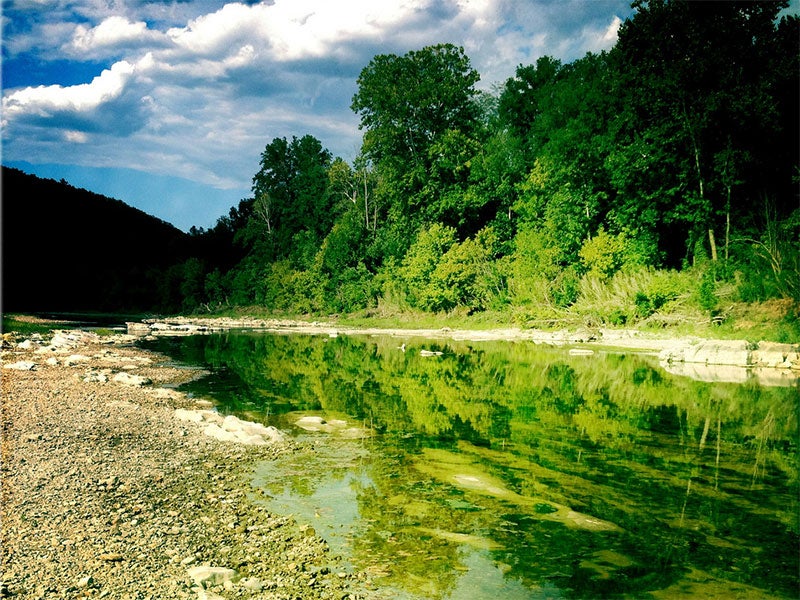Comment Period Ends on Environmental Assessment For Industrial Hog Facility Near Buffalo River
Coalition opposes conclusions of “no impact” made by federal agencies
Contact
The public comment period for a hotly contested environmental assessment of an industrial hog facility in the Buffalo River watershed ended today. This assessment prepared by two federal agencies—the USDA’s Farm Service Agency (FSA) and the Small Business Administration (SBA)—was required by a federal judge who found in a lawsuit filed by the Buffalo River Watershed Alliance, Arkansas Canoe Club, National Parks Conservation Association, and the Ozark Society (the Buffalo River Coalition), that the agencies had failed to adequately consider C&H Hog Farm’s impacts on the environment. The agencies’ reevaluation, however, repeats the initial “finding of no significant impact” (FONSI) about C&H’s impacts.
Located in northern Arkansas, Buffalo National River flows for 150 miles through the Ozarks.
Contrary to the agencies’ conclusions, the facts and best available science show that the unprecedented 6,500-swine C&H operation located in the watershed of the Buffalo National River may indeed have a significant adverse impact on the environment.
Perhaps the biggest flaw in the agencies’ analysis is the unsupported conclusion that the industrial hog facility will have no adverse impacts on water quality—a conclusion that is grounded in the scientifically inaccurate supposition that C&H is not situated on karst. That claim has been thoroughly discredited by experts in the field and the National Park Service, and flies in the face of the overwhelming consensus of the scientific community. Karst is characterized by porous underground geology and drainage systems that enable rapid subsurface water movement. The likelihood of swine waste collected in C&H’s two waste storage ponds and sprayed onto fields finding its way in a karst system into the groundwater and ultimately the Buffalo National River is 95 percent, according to nationally recognized hydrogeologist and karst expert Dr. John Van Brahana.
“The failure by the federal agencies to consider karst and the related water impacts is a fatal flaw in their scientific analysis and discredits most of the findings in the Environmental Assessment and FONSI,” said Dr. Brahana. “The conclusion that there are no impacts on the Buffalo National River or on public health, is predicated on erroneous assumptions. The science shows that this swine operation may have significant adverse impacts, which requires that a full Environmental Impact Statement be prepared.”
Both the National Park Service and the U.S. Geological Survey, which have more direct and relevant expertise than the Farm Service Agency and the Small Business Administration on the geology and hydrogeology of the Ozark region, concur with the statements of scientific experts that C&H is located in a karst system dominated by closely interconnected groundwater and surface water flow.
“A ‘Finding of No Significant Impact’ ignores the considered wisdom of more than a few credible scientists,” said Gordon Watkins, president of the Buffalo River Watershed Alliance. “The Buffalo River Coalition believes there is sufficient risk that environmental damage may or will occur at C&H Hog Farms, that the agencies have dismissed sound science to make a no impact finding, and should be made to produce a full Environmental Impact Statement. A full Environmental Impact Statement is necessary to fully consider the potential significant impacts the agencies have chosen to overlook.”
Read the comments on FSA and SBA Final Environmental Assessment and Draft Finding of No Significant Impact, C&H Hog Farms, submitted by Buffalo River Watershed Alliance, Arkansas Canoe Club, National Parks Conservation Association, and Ozark Society.
Timeline
2012
USDA and SBA make loan guarantees to C&H Hog Farm, an industrial hog facility in the Buffalo National River Watershed.
2013
Groups file lawsuit challenging validity of the 2012 loan guarantees.
2014
U.S. District Court for the Eastern District of Arkansas rules the loan guarantees were issued without an adequate environmental assessment, violating both the Endangered Species Act and the National Environmental Policy Act.
The agencies are ordered to take a second look at C&H’s environmental impacts.
2015
The agencies release their revised environmental assessment, with the same conclusion that they had arrived at unlawfully in 2012.
Today
Public comment period for the final environmental assessment and draft FONSI ends.
BACKGROUND
On August 6, 2013, the Buffalo River Watershed Alliance, Arkansas Canoe Club, National Parks Conservation Association, and The Ozark Society in Arkansas represented by nonprofit law organization Earthjustice, Earthrise Law Center, and attorney Hank Bates filed a lawsuit against the USDA and SBA challenging the validity of loan guarantees made in 2012 to C&H Hog Farm, an industrial hog facility in the Buffalo National River Watershed.
The U.S. District Court for the Eastern District of Arkansas ruled on December 2, 2014 that the loan guarantees to C&H were issued without an adequate environmental assessment, violated both the Endangered Species Act and the National Environmental Policy Act, and ordered the agencies to take a second look at C&H’s environmental impacts.
In August 2015, the two federal agencies released their revised environmental assessment and arrived at the same conclusion that they had arrived at unlawfully in 2012. The public comment period for the final environmental assessment and draft FONSI ends January 29, 2016.
The pristine waters of the Buffalo River, Arkansas’ crown jewel, meander for 150 miles through the Arkansas Ozarks. The economic importance of the river to the region cannot be overstated. Approximately 1.3 million visitors visit the river each year according to the National Park Service, spending more than $50 million in the surrounding communities.

Additional Resources
About Earthjustice
Earthjustice is the premier nonprofit environmental law organization. We wield the power of law and the strength of partnership to protect people's health, to preserve magnificent places and wildlife, to advance clean energy, and to combat climate change. We are here because the earth needs a good lawyer.